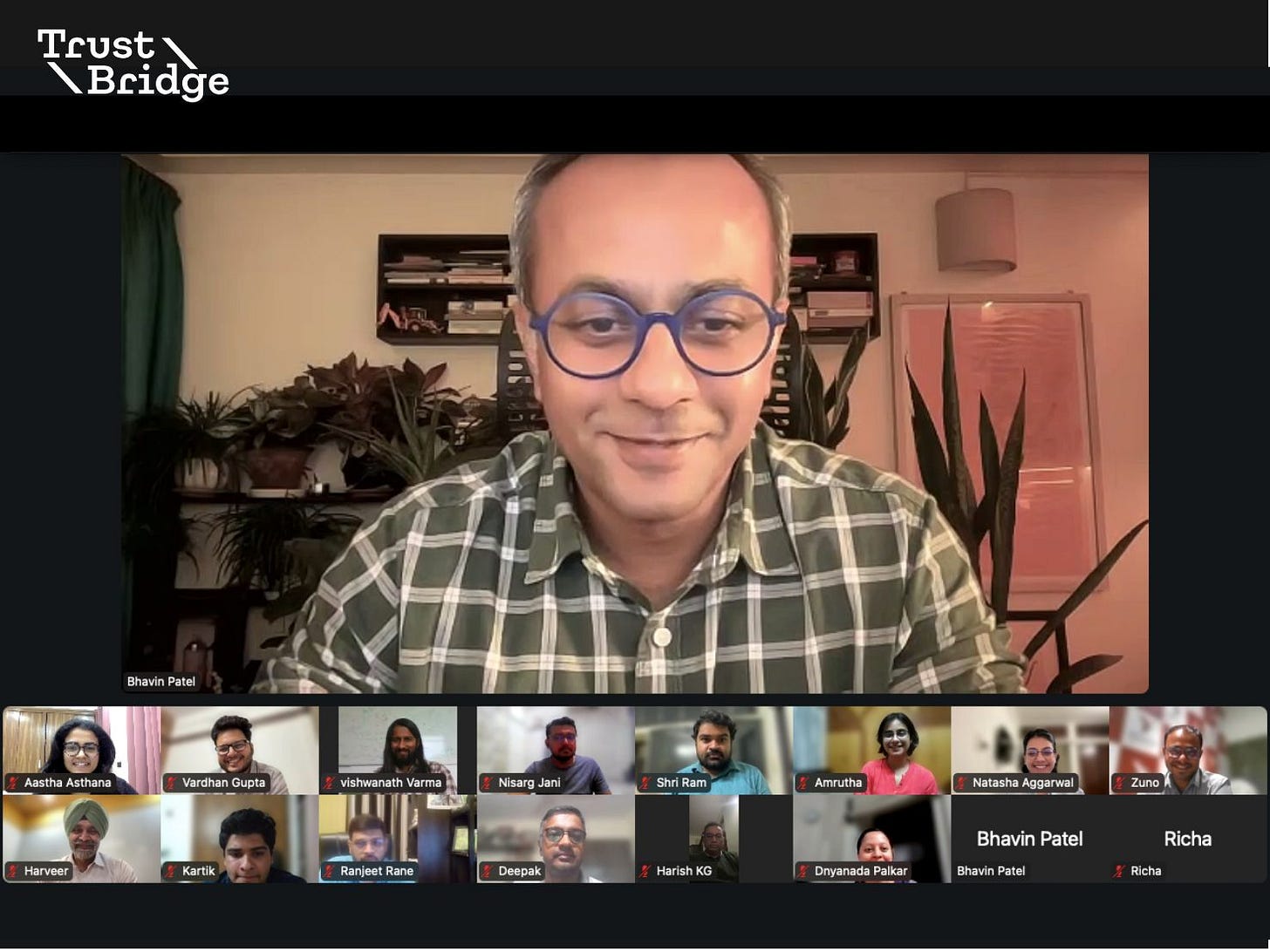PWD's exit from Arbitration | Bargains and Banking | LLMs for Regulators | Draft AIF Directions | Consultative Regulation | The TrustBridge Newsletter | Issue 22
SC Practice Rules | AI Knowledge Consortium | Dispute Resolution Dialogues | Questions that matter - six new episodes
This is TrustBridge’s monthly newsletter. TrustBridge seeks to improve India’s business environment by improving the rule of law. This month, we shared our observations on evolving government strategies in arbitration and contributed to the recent discourse on judicial appointments. Through our 'Questions That Matter' video series, we addressed topics ranging from public procurement arbitration to writing good regulatory orders. In parallel, we submitted comments to the RBI on its draft directions on AIFs, delivered a session on legal design as part of a policy training program, and presented ongoing work on how LLMs can assist regulators in writing better adjudicatory orders. We continued our Dispute Resolution Dialogues with a session exploring empirical insights into patent illegality in Indian arbitration.
Read on to see what’s kept us busy.
Trainings
Bhavin Patel, Natasha Aggarwal, and Amrutha Desikan taught an online course on ‘Using LLMs for Regulatory Analysis’ on the Open Takshashila platform, from May 20 - June 6, 2025.
Participants explored how the sheer volume and complexity of regulatory instruments make large-scale research and analysis challenging, a problem for which LLMs can be transformative. The interactive course was foregrounded in legal and economic approaches and exemplified the use of LLMs through our analysis of the regulatory orders of SEBI and State Electricity Regulatory Commissions.
Prashant Narang conducted a session titled, ‘Legal design: research, writing, and legislative drafting’ on June 5, 2025 as part of the Researching Reality programme by the Centre for Civil Society. The session focused on how research can play a key role in simplifying and improving the accessibility of legal frameworks, making them more understandable and actionable.
Partnerships and collaborations
TrustBridge is delighted to have been inducted as a member of the AI Knowledge Consortium (AIKC), a 16-member group of research-led organisations advancing AI governance in India through dialogue and research. Amrutha Desikan attended AIKC’s roundtable discussion titled, “Ingest, Generate, Compete: India’s Roadmap for AI, IP, and Competition”, focussing on the implications of AI for copyright law and competition law.
Consultation response
In June, Renuka Sane, Bhavin Patel, Natasha Aggarwal, and Aastha Asthana submitted comments to the Reserve Bank of India on the draft Reserve Bank of India (Investment in AIF) Directions, 2025.
Past events
TrustBridge hosted the fourth session of Dispute Resolution Dialogues, featuring a talk by NLSIU, Bangalore students, Pratyush Singh and Aastha Malipatil, on their paper ‘Empirical Insights into the Legal Quicksand: The Case of Patent Illegality in Indian Arbitration’ on May 16, 2025.
The talk delved into the intriguing evolution of patent illegality in Indian arbitration law, a concept formalised by the Supreme Court in the Saw Pipes case and later refined by the 2015 amendment to the Arbitration and Conciliation Act, 1996. The presenters analysed 699 cases from 2016 to 2023 revealing a striking 29.38 per cent success rate for arguments based on patent illegality.
Bhavin Patel and Amrutha Desikan presented TrustBridge’s work on ‘Using LLMs to improve state capacity in regulatory order writing’, at XKDR Forum's 13th Indian Legal System Reform Seminar, on June 13, 2025.
Papers
Renuka Sane has co-authored a research paper titled ‘Bargains and Banking: How Institutionalized Political Bargains Have Shaped the Development of Indian Banking’, published in Studies in Comparative International Development on May 23, 2025. The abstract for the paper is below:
This essay shows how the sectoral political network in India’s banking sector has structured its development, from the era of dirigisme beginning under the Nehru government in 1947, to the more liberalized contemporary period starting in 1991. We show that political bargains, or institutionalized agreements among actors in a sectoral political network, are mechanisms through which the legacies of earlier eras shape developments in subsequent periods. Our study of India’s banking sector examines two varieties of political bargains. Politicians created an entrenched political bargain during the dirigiste era by nationalizing India’s banks to assert control over bank governance.
Entrenched bargains limit subsequent reforms to policies that address their negative consequences but not the underlying causes emanating from the interests of powerful actors. Principal-agent relations are the second type of political bargain. Politicians struck this evolving bargain by establishing an asymmetric relationship between the government and India’s central bank, the Reserve Bank of India (RBI). We analyze how these entrenched and principal-agent bargains have shaped the development of Indian banking by examining their impact on the banking sector’s recurring non-performing asset problem and its dynamic payment system.
Perspectives
Prashant Narang published a guest post titled ‘PWD’s retreat from arbitration: a government signal, not a market verdict - a thoughtful reflection on Abiha’s “wake-up call’, for Regulatory Dispatch on May 20, 2025.
PWD’s exit from arbitration reminds us again about the persistent, structural misalignment of incentives when the government is both rule-maker and the country’s largest award debtor. Rather than relying solely on command-and-control mandates or prescriptive models, genuine progress will come from reforms that reward early, efficient settlement and tie accountability to real outcomes.
If incentives are structured so that speed, transparency, and effective resolution are valuable-for both claimants and the government, then mediation frameworks and innovations like online dispute resolution can evolve from policy aspirations into practical, trusted tools.
Op-eds
Chitrakshi Jain co-wrote an opinion piece for the Economic Times, titled ‘Supreme Overreach’, on May 22, 2025.
It’s time to question the basis for prescribing different practice requirements for judicial offices depending on location of the office within the hierarchy. Knowledge of law and judicial instincts required by a judicial magistrate and a civil judge are the same as those required of a district judge.
When a person is arrested, police need to produce the accused before a judicial magistrate within 24 hours. Many are produced without legal representation. It is the judicial magistrate who must peruse the paperwork filed by the police and determine whether the arrest is legal, and whether the detainee has been tortured by the police. This is an onerous responsibility requiring a great degree of skill.
Natasha Aggarwal published an article in The Hindu, titled ‘Consultative regulation-making that should go further’ on June 09, 2025.
Good regulatory practice warrants meaningful justification for regulatory intervention, and the RBI and SEBI have taken the initial steps in that direction. Notably, limited state capacity is a significant hurdle to implementing regulatory impact assessments and consultative practices. Moreover, piecemeal reforms by individual regulators may not be sufficient to ensure consistent adherence to good regulatory practice. Parliament could contemplate enactment of a law, similar to the Administrative Procedure Act in the United States, with standardised procedures for regulation-making, which includes impact analysis, public consultation and periodic review.
Renuka Sane published an article in The Print, titled ‘SECI’s overly cautious procurement rules will deter investors from India’s renewable projects’ on June 16, 2025.
Restrictions of the kind placed by SECI make it harder for developers to attract the kind of long-term institutional investment that is essential for scaling up. If India is serious about achieving its 500 GW non-fossil fuel capacity target by 2030, SECI’s procurement design will need to accommodate the realities of how projects are developed, financed, and transferred. The Ministry of Power and SECI need to take a more nuanced view of transparency. It should not mean unfiltered visibility into every last detail. Rather, it should begin with a clear articulation of objectives—whether financial security, competition, national security or some other objective—and search for the tool that best meets the specific objective.
Videos
We published six episodes of the series ‘Questions That Matter’ on our YouTube channel:
Episode 8: Public Procurement – Arbitration Reforms and the Core Judgment
Episode 10: Why Do Indian District Courts Delay Justice?
Episode 11: Writing Good Regulatory Orders
Episode 12: SEBI's Insider Trading Enforcement (Part 1)
Episode 13: SEBI's Insider Trading Enforcement (Part 2)
Work with us
If our work resonates with you and you would like to contribute, we’d love to hear from you. Reach out to us at info@trustbridge.in, we’re always open to working with like-minded individuals.
Thanks for reading The TrustBridge Newsletter! Subscribe for free to receive new posts and support our work.















